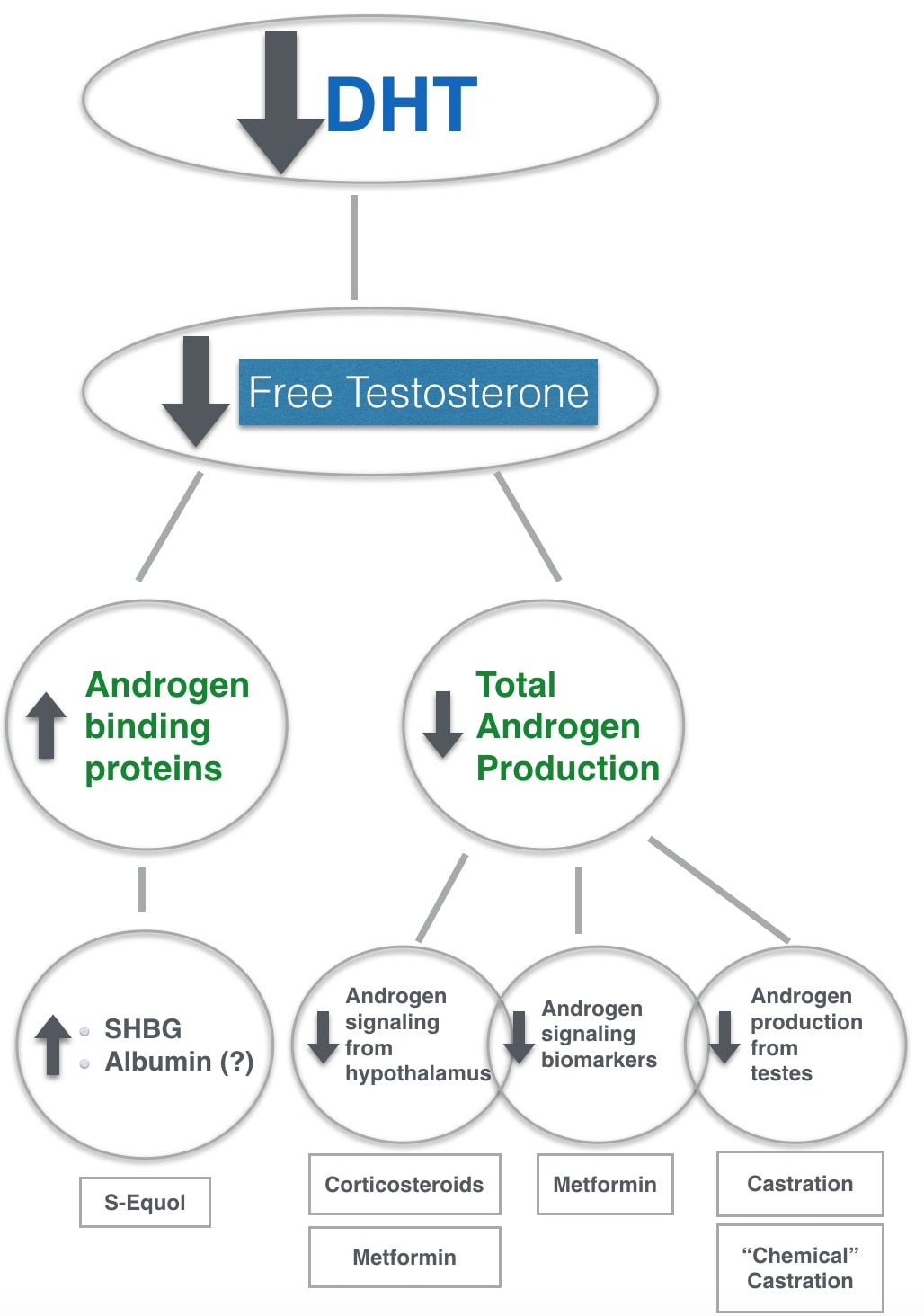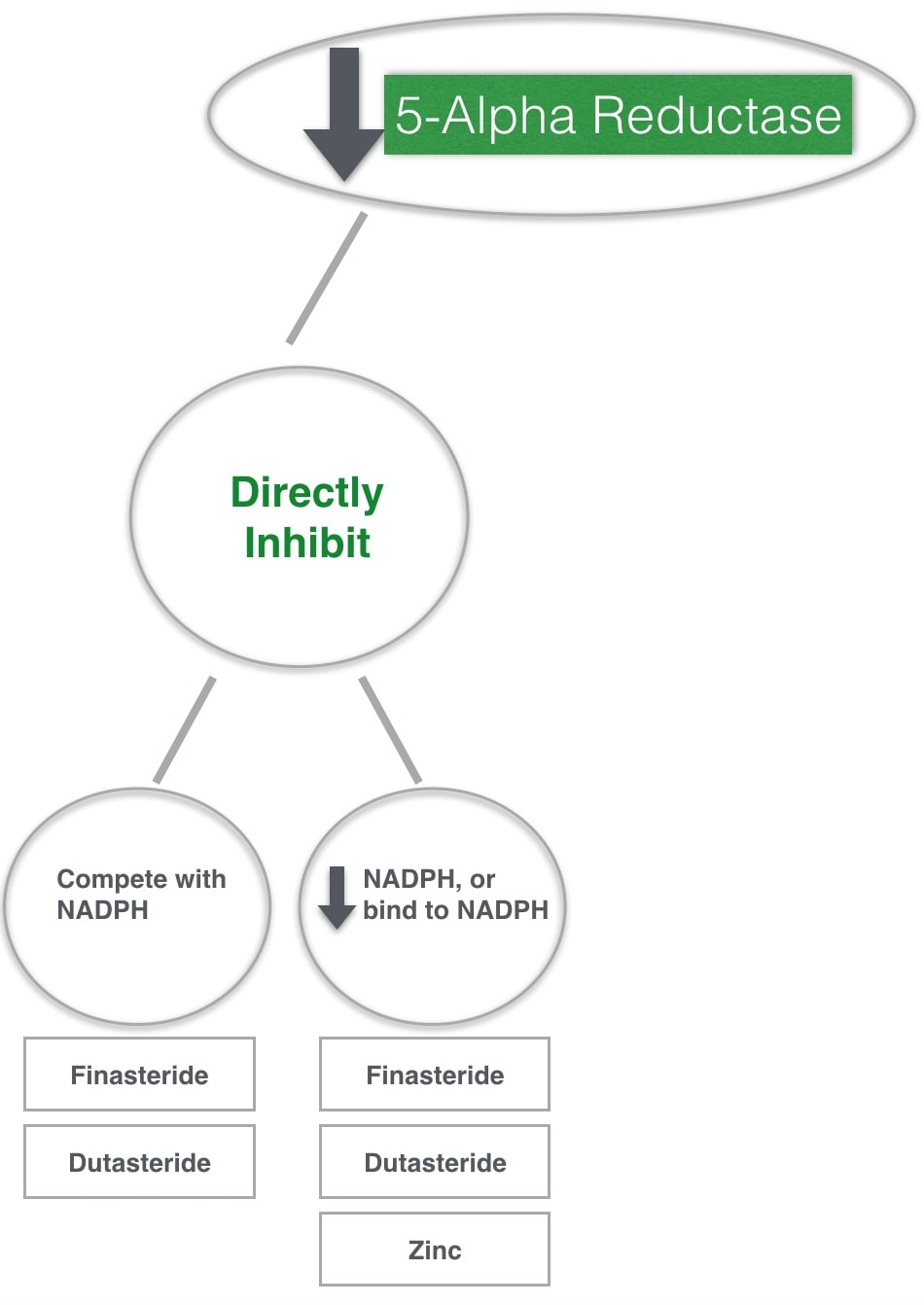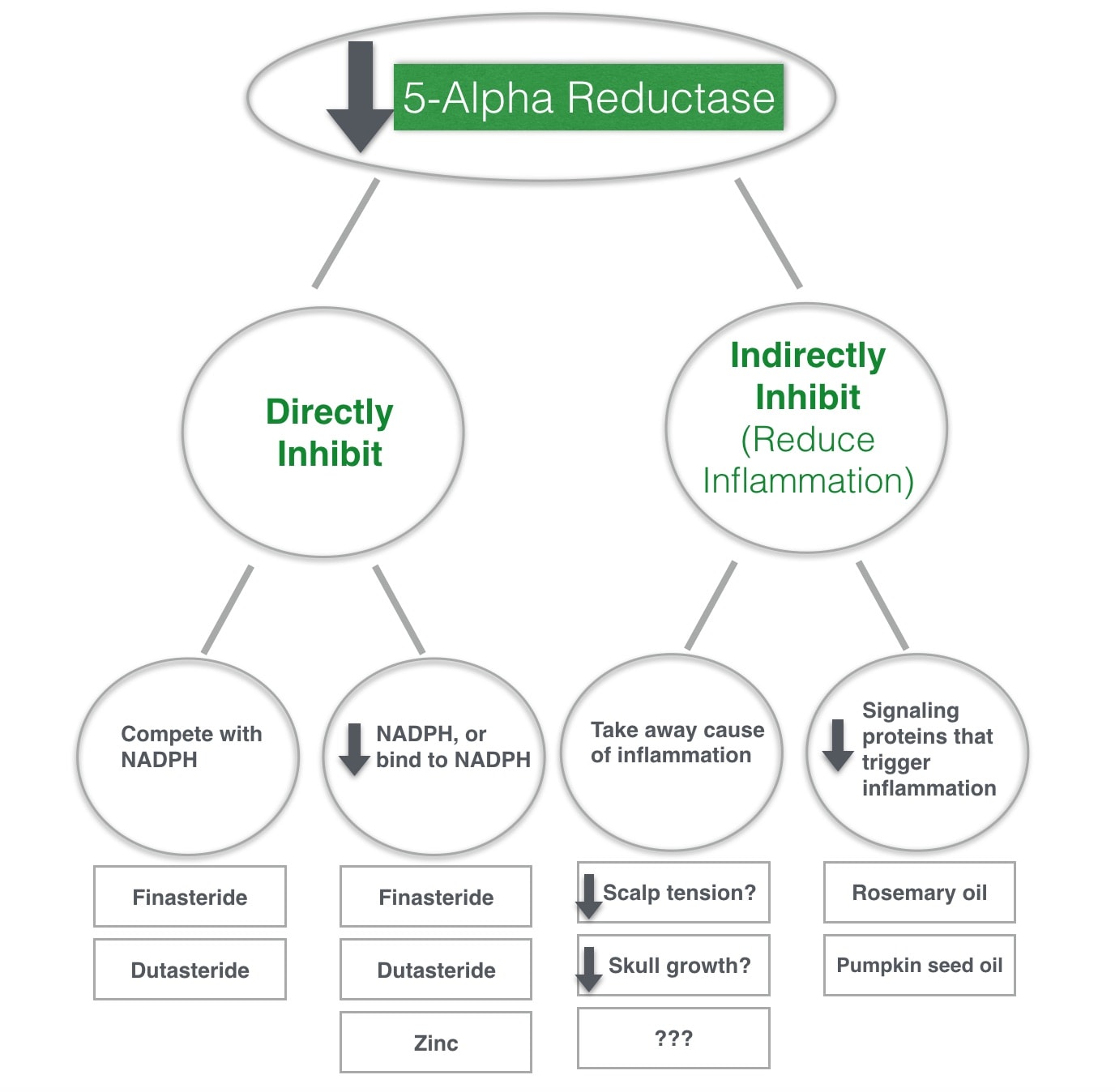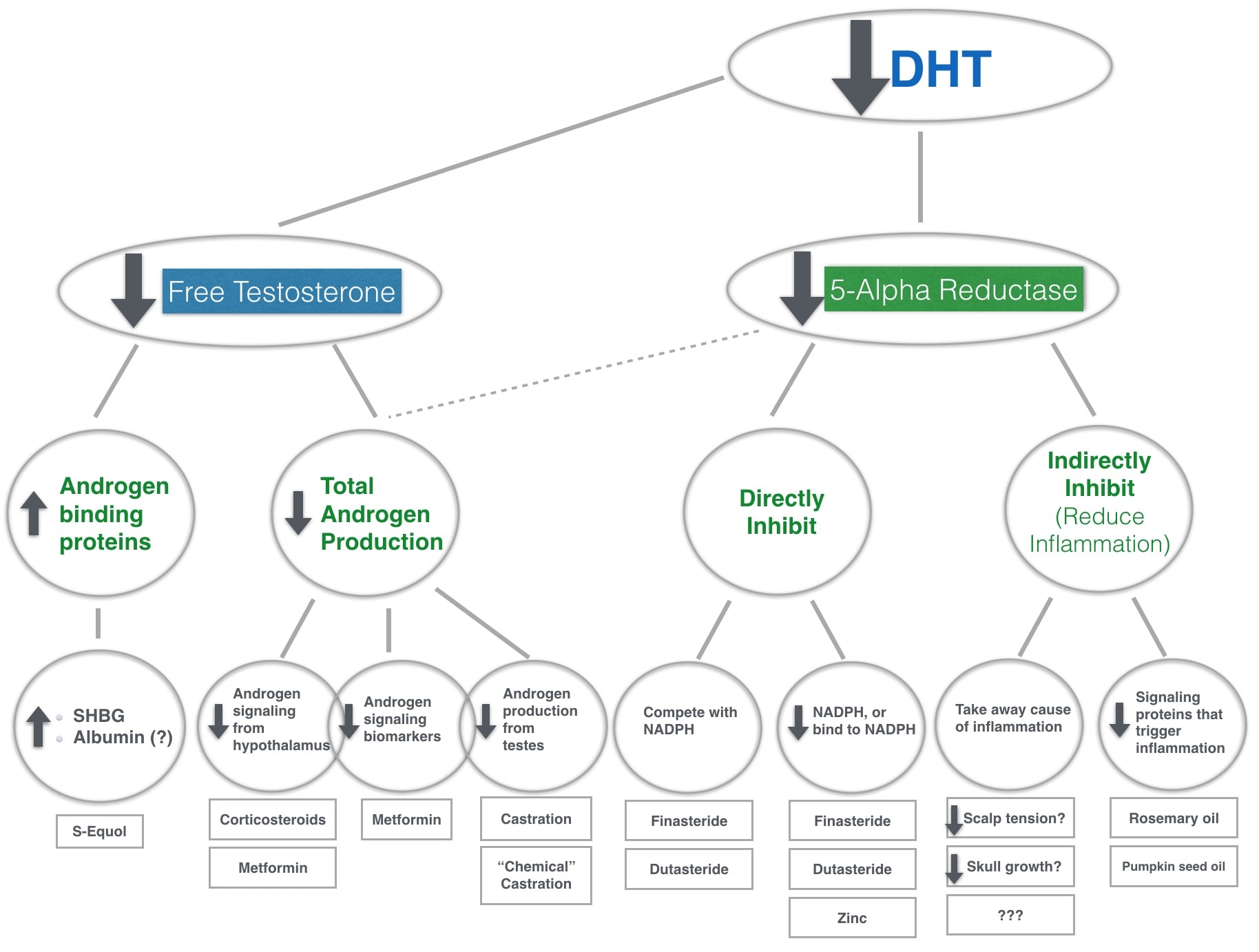Read time: 10 minutes
Note: this is part two of a four-part series — a master guide to reducing DHT levels for the purpose of fighting hair loss. Missed part one? Read it right here.
Part One Summary – Decreasing DHT By Reducing Free Testosterone
In the last article, we uncovered what DHT is, how it’s made, the DHT-hair loss connection, and the four major levers to reduce DHT levels in hopes of stopping hair loss:
- Decrease free testosterone
- Inhibit 5-alpha reductase
- Decrease androgen receptors
- …and one more we haven’t yet revealed
Then we dove into all the ways we can decrease DHT by using that first lever: reducing free testosterone. Here’s a summary of the mechanisms (but not all the drugs, foods, supplements, and treatments that target these mechanisms):
Unfortunately, most of these approaches are bad ideas. For instance – yes, we can theoretically plummet DHT production via castration. And yes, castration has been shown to significantly slow or stop pattern hair loss. But for most men, the consequences of castration far outweigh the pain of losing our hair.
So when it comes to reducing DHT by decreasing free testosterone, we don’t have many viable options…
The good news? There are still three other levers of attack against DHT.
The one we’ll cover inside this article: inhibiting the enzyme 5-alpha reductase.
Part Two: Decreasing DHT By Inhibiting 5-Alpha Reductase
Review: Three Levers Of DHT Reduction
Remember: in order for dihydrotestosterone (DHT) to form, we need all of the following present:
- Free testosterone
- 5-alpha reductase
- Androgen receptors
As a result, this gives us three major levers to reduce DHT levels: decrease 1) free testosterone, 2) 5-alpha reductase, and / or 3) androgen receptors.
We’ve already covered the major ways to reduce free testosterone (and thereby decrease DHT). Now it’s time to move onto the enzyme 5-alpha reductase.
What Is 5-Alpha Reductase?
5-alpha reductase is the enzyme our bodies use to convert free testosterone into DHT. And without the enzyme 5-alpha reductase, DHT cannot form (at least at relatively high quantities).
There are many types of 5-alpha reductase, but when it comes to hair loss, the one that gets the most attention is type II 5-alpha reductase.
Type II 5-alpha reductase is the enzyme expressed in our scalp skin and prostate. Some men have a rare genetic mutation where their bodies can’t produce any type II 5-alpha reductase. And interestingly enough, these men don’t go bald.
The net: we need type II 5-alpha reductase to make DHT in our scalp skin. And that means if we can reduce the expression of type II 5-alpha reductase, we can also reduce our DHT levels (and possibly prevent or partially reverse pattern hair thinning).
Which brings us to our second angle of attack against DHT…
Angle Of Attack #2: Reducing 5-Alpha Reductase
There seems to be at least two pathways to inhibiting (or reducing the presence of) this enzyme.
- Directly (competitively inhibit 5-alpha reductase)
- Indirectly (reduce inflammation)
Let’s take these one-by-one.
#1: Direct 5-Alpha Reductase Inhibition
Competitive Inhibition
5-alpha reductase doesn’t just arrive out of nowhere. In order for this enzyme to form and mediate the whole DHT conversion process, it needs the help of a coenzyme known as nicotinamide adenine dinucleotide phosphate… or in other words, NADPH.
5-alpha reductase needs NADPH to convert free testosterone into DHT. So an effective way to stop the formation of 5-alpha reductase (and reducing DHT) is to…
- Compete with the coenzyme NADPH, or…
- Block NADPH
These are two mechanisms of direct 5-alpha reductase inhibition – or for the lay person – reducing 5-alpha reductase by stopping it from forming. The hair loss drugs Finasteride and Dutasteride – two 5-alpha reductase inhibitors – appear to work in this way.
Mechanism 1: Compete With NADPH
Some research shows that Finasteride competes with the coenzyme NADPH. Finasteride’s molecules take the place of NADPH in a cell, and in NADPH’s absence, 5-alpha reductase cannot form. The end-result? Less DHT. And another 5-alpha reductase inhibiting drug – Dutasteride – seems to do the same thing (using a slightly different molecule).
Mechanism 2: Block NADPH (Or Bind To NADPH And Change Its Structure)
There’s also research showing that instead of competing with NADPH, Finasteride may instead bind to NADPH and change NADPH’s structure into a different coenzyme – one that doesn’t support the formation of 5-alpha reductase. The bottom line: free testosterone can no longer convert into DHT.
Interestingly, zinc may also reduce 5-alpha reductase and through a similar manner. Evidence suggests that zinc reduces NADPH production, thereby decreasing 5-alpha reductase activity. The less enzyme activity, the less DHT.
And that’s a (very) brief overview of how to reduce DHT levels by directly inhibiting the enzyme 5-alpha reductase.
#2: Indirect 5-Alpha Reductase Inhibition
Reduce Inflammation
Studies show there’s an association with DHT and inflammation. The net: DHT might regulate the inflammatory process. And in some tissues, increased DHT might even be a response to increased inflammation.
Hypothetically, if we can reduce inflammation, we might also reduce 5-alpha reductase activity (and thereby DHT levels).
Interestingly, reducing chronic inflammation may be an indirect way of reducing 5-alpha reductase. This is because reducing inflammation doesn’t directly inhibit 5-alpha reductase, but rather, inhibits the inflammation that signals 5-alpha reductase to arrive in certain tissues (like our scalp skin and prostates).
There are hundreds of ways to reduce chronic inflammation. But most boil down to two methods: we can either 1) take away whatever’s causing the inflammation in the first place, or 2) stop the signaling proteins that tell our bodies to send inflammatory cells to injury sites.
In the case of pattern hair loss, we don’t really know what causes chronic inflammation in our scalps. It could be scalp muscular tension, protruded bone growth, skin tightening, the arrival of DHT to genetically sensitive hair follicles, an inflammatory marker induced by DHT… the list goes on. But since we don’t know the cause, we’re more or less stuck with that second inflammation-reducing option: muting signaling proteins that channel inflammatory cells to injured tissues.
Fortunately, there are hundreds of substances that can do this. Covering each is out-of-scope for this article, so we’ll instead highlight just two.
Again, the list here is not a suggestion that you should use these methods. They’re just examples of substances that might hit these pathways.
- #1: Pumpkin Seed Oil
- Antioxidants: decrease oxidation, decrease transforming growth factor beta
- Linoleic acid: decreases COX-2 enzyme
- #2: Rosemary Oil
- Polyphenols: decreases COX-2 enzyme
- Volatile oils: decreases COX-2 enzyme, interleukins, and tumor necrosis factor
Recap: Direct Vs. Indirect 5-Alpha Reductase Inhibition
We can decrease DHT by inhibiting 5-alpha reductase through two major pathways: direct versus indirect 5-AR inhibition. Direct 5-AR inhibition is how steroid-derived hair loss drugs like Finasteride and Dutasteride work.
Conversely, we may be able to indirectly inhibit 5-alpha reductase by reducing inflammation in tissues. Inflammation and hair loss are closely linked, but since we don’t yet know what causes the inflammation that triggers hair loss, we’re more or less limited to reducing scalp inflammation by simply inhibiting the signaling proteins that send more inflammatory cells to those tissues. Rosemary oil and pumpkin seed oil have these anti-inflammatory properties. Unfortunately, they’re less studied in terms of hair loss, and probably aren’t as effective at stopping hair loss versus Finasteride (Propecia) or Dutasteride (Avodart).
Any Other Ways To Reduce 5-Alpha Reductase – Directly Or Indirectly?
Absolutely.
There’s evidence that polyunsaturated fatty acids like linoleic acid may act directly and indirectly on 5-alpha reductase by 1) reducing inflammation, and 2) altering lipid bilayers in cell membranes to decrease 5-alpha reductase formation.
There’s also evidence that vitamin B2- also known as riboflavin – may decrease 5-alpha reductase activity, though the mechanisms aren’t completely understood.
Even the polyphenols inside green tea may inhibit 5-alpha reductase.
The pathways these substances take to reduce 5-alpha reductase are complex, and they’re still being explored. As a result, I’ve omitted these from the flowchart until studies can confirm their exact mechanisms.
Finally – we can also reduce 5-alpha reductase activity by decreasing total androgen production. The less androgens our bodies produce, the less 5-alpha reductase is activated. This was covered in the first article about reducing free testosterone, and as a result, we won’t cover it again here.
Again, there’s very limited research on the effects of these non-drug strategies on hair loss outcomes. Nonetheless, I figured I’d mention them.
Summary Of Series (So Far)
When it comes to fighting hair loss by reducing DHT, there are four main levers of attack:
- Reducing free testosterone
- Inhibiting 5-alpha reductase
- Blocking androgen receptors
- A mystery lever (we’ll get to that soon)
In the last article, we covered the major ways of reducing DHT by reducing free testosterone, and provided some examples of the drugs and supplements which achieve this (inadvertently or not).
In this article, we uncovered how we can reduce DHT by inhibiting 5-alpha reductase – and through a variety of mechanisms.
So let’s combine what we know so far into one major flowchart. So far, we’re 2/4’s of the way to a complete DHT Reduction Master Flowchart:
Remember, the drugs and supplements listed above are just examples. These are by no means the most effective drugs and supplements within their respective categories, nor are they the only drugs or supplements that can achieve these effects. This flowchart is educational and not endorsing of any specific treatment.
What’s To Come…
The third installment of a Master Guide To The Mechanisms Behind DHT Reduction uncovers how to decrease DHT by decreasing androgen receptors.
Anyone researching or experimenting with additional ways to reduce 5-alpha reductase? Leave a comment! I respond to everyone.

Rob English is a researcher, medical editor, and the founder of perfecthairhealth.com. He acts as a peer reviewer for scholarly journals and has published five peer-reviewed papers on androgenic alopecia. He writes regularly about the science behind hair loss (and hair growth). Feel free to browse his long-form articles and publications throughout this site.







Hi Rob,
Great job on the research!
One note worth mentioning. Be careful with zinc. Too much of it (more than 10 micrograms) according to: http://www.belgraviacentre.com/blog/four-vitamins-and-minerals-that-can-cause-hair-loss/ can increase hair loss.
I always found the side effects of drugs, particularly losing more hair after cessation, fascinating! I asked myself, Rob, why does the body react in that manner? Shouldn’t we still keep our gains even if we pull the plug on drugs?
This is just my observation, but I think most people are oblivious (and I don’t blame them for the lack of oversight from the medical industry) about why these drugs act in this manner (i.e. why I lose more hair if I stop using them). Your article on why you stop using shampoos struck an accord with me in relation to my observation on losing more hair when you stop using drugs.
Whenever we manipulate our natural, biological framework, artificially (in the form of drugs, synthetic shampoos, and other household cosmetics) we’re tampering with our physiological and psychological state.
I remember when I stopped using shampoos, my hair was oilier than before. Why? I think a strong reason is I got acclimated to shampooing. As soon as I eliminated shampoos, my body recognized a deficiency in sebum production. As a result, my body fed that deficiency by overexerting sebum. Stated differently, to compensate for the loss of sebum, my body was tricked from the shampoos to produce more sebum after I stopped shampooing to bring back normality.
If we use this shampooing analogy with losing more hair after drugs cessation we formulate an educated observation on the specific cause(s) behind this paradox. Hair loss drugs, like mentioned in this article, are very effective for demolishing DHT ARTIFICIALLY.
However, when we rely on them over a long period of time, the body just like my shampooing experience gets used to the artificial change. As soon as we intervene as a hindrance to this process by eliminating the usage of drugs, which by the way, the body still recognizes as “natural”, we reprogram ourselves to come back to our natural senses. The downfall is the body now recognizes a deficiency in our DHT levels and thus, produces more DHT in the blood, which further attacks more of our hair follicles.
To wrap it up in a nutshell, the reason why we probably lose more hair after terminating drugs is the overproduction of DHT perpetrated by our bodies because it thinks we have little to no DHT as a result of taking these drugs.
For more information, if you or any of your readers are interested, you can visit my YouTube channel at: https://www.youtube.com/c/RebornHairPPP.
Thanks Rob again, and keep it coming!!!
Hi reborn hair,
I read the link about Belgravia that you gave but they didn’t give any study or link btw The RDA for zinc is 10mg-12mg (milligram) not 10 microgram.
I would have liked to see the study design , participants , blood mineral & vitamin levels etc
Besides they say
” Vitamin A is not only found in food and drinks but is also present in acne medications such as Accutane and Roaccutane ” – I am not sure if the compound in accutane is retinol but its quite similar to it. It shows vitamin A like actions at some receptors but shows antagonist actions at other places.
Thanks Joe.
To echo Dante’s comments, I’d love to see some elaboration of how high-doses of zinc can cause hair loss. I’ve actually found the opposite in my research – with “mega dosing” of zinc to even reverse hair loss (alongside thyroxine and a multivitamin) in this case study:
https://www.ncbi.nlm.nih.gov/pmc/articles/PMC3746228/
Now there are risks associated with zinc supplementation — specifically, a copper deficiency. But I’ve yet to see data showing that high levels of zinc promote hair loss. I’ve found this to be a trend with the Belgravia Institute… They make a lot of claims that they don’t back up, and expect trust out of their readers because they’re considered an “authority” source of information. I’d love to see from where they really get their information!
Hi rob,
The lady was deficient in zinc so I could understand how it helped. As far zinc induced hair loss is concerned , its possible as copper in involved as a conenzyme in one of the reactions for thyroid ,so high doses of zinc over long period can cause hypothyroidism(as you said by causing copper deficiency). I have read some people saying it made their extremities cold which sounds like a classic sign of hypo
Thanks Dante. That makes sense to me. I’ve read case reports of prolonged mega-doses of zinc causing copper deficiencies that eventually lead to long-standing neurological impairments. And it pays to reiterate: this is one of the reasons why I try to default to food sources for nutrients — because supplementation can reap unintended consequences. Most people supplement blindly without any understanding of nutrient balancing or dosage. Your point just goes to show how important this is.
Hi Rob and Dante ,
I would not trust Belgravia at all !
They are a business which sell medicines like propecia and minoxodil, and use the FDA as a reason to do so. They do put up some interesting articles , but the agenda I notice is always to promote finisteride and their own products.
Again there needs to be hard evidence that zinc causes loss in high dosage, as I’ve read the opposite.
Thanks
Thanks Dante, Rob, and Paz for the insight. Didn’t know that was the case for Belgravia.
One must very skeptical and careful nowadays to trust sources that appear to be legitimate.
Take care!
Rob,
Great article, I was especially interested in the idea that DHT accumulation may be a result of inflammation triggered by inflammatory signaling proteins already present. Seems like solid evidence showing that DHT and inflammation are not separate, but have a rather causal relationship in pattern hair loss.
This study showed the importance of 5a-reductase inhibition’s importance in reduced volume and inflammation of the prostate gland.
https://www.ncbi.nlm.nih.gov/pubmed/16515494
“By inhibiting the production of dihydrotestosterone (DHT) locally within the prostate gland, 5a-reductase inhibitors have the effect of reducing prostate volume, improving lower urinary tract symptoms, increasing peak urinary flow, and decreasing the risk of acute urinary retention and need for surgical intervention.”
So, when 5a-reductase is inhibited, the less DHT accumulation, which means the tissue becomes less inflamed. The antagonists caused the smooth bladder muscle tissue to relax and become less resistant to urine flow. Knowing that it has this effect on the prostate gland, it could show similar effects in the scalp tissue!
Thanks!
Hey Rob,
very interesting article, thanks for sharing all this!
I was wondering why you haven’t mentioned anything about the 5a-reductase inhibitory effects of curcumin as studied in following research:
https://www.ncbi.nlm.nih.gov/pmc/articles/PMC4618860/
Based on this study the inhibitory effects of curcumin seems to be even greater than Finasteride. Have you heard about it before?
I came across this study when I was thinking of starting a morning routine of taking a daily shot of apple cider vinegar, lemon, ginger, TURMERIC and cayenne pepper mixture (look it up, great stuff).
Hey Jonas,
Thanks for reading. I read through your linked study, and it appears the study measured curcumin’s effects on prostate tissue, and its influence of transforming growth factor beta 1, VEGF, and IGF-1. The study demonstrated curcumin’s marked decrease of TGF-B1 and on-par with finasteride’s effect on the same biomarker, but unfortunately, I didn’t see where the study measured curcumin’s effects on 5 alpha reductase.
With that said, this study demonstrates that curcumin reduces inflammatory signaling proteins commonly associated with enlarged prostate diseases, and that’s a great sign. It’s very likely curcumin indirectly decreases 5 alpha reductase by reducing inflammation. So it shouldn’t hurt to take it!
Best,
Rob
Hey Rob,
thanks for taking your time to answer. You’re absolutely correct, the 5 alpha reductase inhibition hasn’t been analysed directly. Got carried away by other sites claiming the DHT blocking effect of curcumin. Thanks for clarification and much appreciation for your work here!
Cheers,
Jonas
No worries Jonas! Thanks for letting me know. It’s incredibly frustrating how much misinformation is out there – and it feels like an Atlas task trying sift through it all. Let me know if any other questions comes up. For what it’s worth, curcumin is a powerful anti-inflammatory that likely has other pro-hair benefits outside of DHT reduction.
Hi Rob,
I found you blog lately and I must say the information you provided is very informative. I have a few queries regarding the DHT pathway, which I hope you could throw in some of your ideas.
1) I saw quite a number of finasteride user complain that finasteride induce Telogen Effluvium for such a long time (more than 3 months). Is it even possible and what is your take regarding this ?
2) There has been rumors/theories that, by reducing DHT, the Androgen Receptors on the scalp is getting more and more sensitive and even up-regulate over time and guess what, even a small amount of DHT (the remaining DHT that finasteride failed to block) can still make the us bald faster. What is your take regarding this ?
Many thanks.
Hi Rob. But isn’t curucmin will block enzyme that is required for minoxidil conversion into minoxidil sulfate? Im taking oral minoxidil and I’m afraid about it a little.